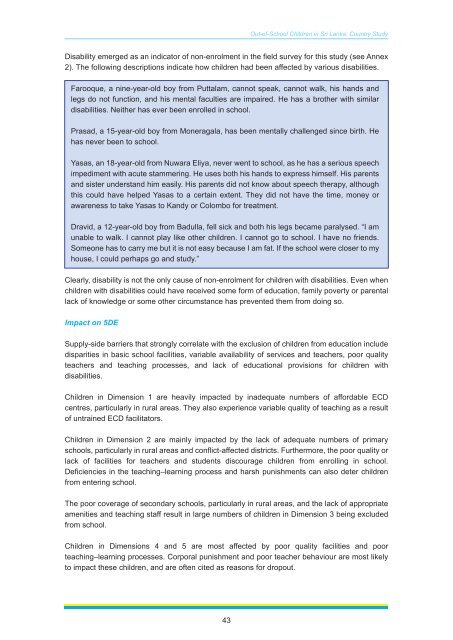Sri Lanka - Institut de statistique de l'Unesco
Sri Lanka - Institut de statistique de l'Unesco
Sri Lanka - Institut de statistique de l'Unesco
Create successful ePaper yourself
Turn your PDF publications into a flip-book with our unique Google optimized e-Paper software.
Out-of-School Children in <strong>Sri</strong> <strong>Lanka</strong>: Country Study<br />
Disability emerged as an indicator of non-enrolment in the field survey for this study (see Annex<br />
2). The following <strong>de</strong>scriptions indicate how children had been affected by various disabilities.<br />
Farooque, a nine-year-old boy from Puttalam, cannot speak, cannot walk, his hands and<br />
legs do not function, and his mental faculties are impaired. He has a brother with similar<br />
disabilities. Neither has ever been enrolled in school.<br />
Prasad, a 15-year-old boy from Moneragala, has been mentally challenged since birth. He<br />
has never been to school.<br />
Yasas, an 18-year-old from Nuwara Eliya, never went to school, as he has a serious speech<br />
impediment with acute stammering. He uses both his hands to express himself. His parents<br />
and sister un<strong>de</strong>rstand him easily. His parents did not know about speech therapy, although<br />
this could have helped Yasas to a certain extent. They did not have the time, money or<br />
awareness to take Yasas to Kandy or Colombo for treatment.<br />
Dravid, a 12-year-old boy from Badulla, fell sick and both his legs became paralysed. “I am<br />
unable to walk. I cannot play like other children. I cannot go to school. I have no friends.<br />
Someone has to carry me but it is not easy because I am fat. If the school were closer to my<br />
house, I could perhaps go and study.”<br />
Clearly, disability is not the only cause of non-enrolment for children with disabilities. Even when<br />
children with disabilities could have received some form of education, family poverty or parental<br />
lack of knowledge or some other circumstance has prevented them from doing so.<br />
Impact on 5DE<br />
Supply-si<strong>de</strong> barriers that strongly correlate with the exclusion of children from education inclu<strong>de</strong><br />
disparities in basic school facilities, variable availability of services and teachers, poor quality<br />
teachers and teaching processes, and lack of educational provisions for children with<br />
disabilities.<br />
Children in Dimension 1 are heavily impacted by ina<strong>de</strong>quate numbers of affordable ECD<br />
centres, particularly in rural areas. They also experience variable quality of teaching as a result<br />
of untrained ECD facilitators.<br />
Children in Dimension 2 are mainly impacted by the lack of a<strong>de</strong>quate numbers of primary<br />
schools, particularly in rural areas and conflict-affected districts. Furthermore, the poor quality or<br />
lack of facilities for teachers and stu<strong>de</strong>nts discourage children from enrolling in school.<br />
Deficiencies in the teaching–learning process and harsh punishments can also <strong>de</strong>ter children<br />
from entering school.<br />
The poor coverage of secondary schools, particularly in rural areas, and the lack of appropriate<br />
amenities and teaching staff result in large numbers of children in Dimension 3 being exclu<strong>de</strong>d<br />
from school.<br />
Children in Dimensions 4 and 5 are most affected by poor quality facilities and poor<br />
teaching–learning processes. Corporal punishment and poor teacher behaviour are most likely<br />
to impact these children, and are often cited as reasons for dropout.<br />
43

















